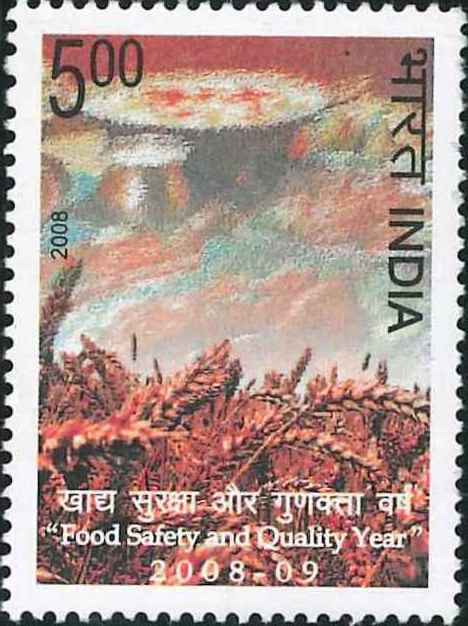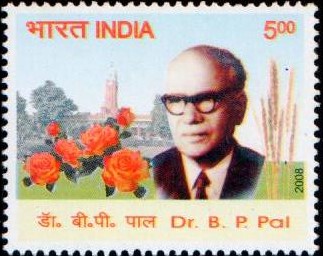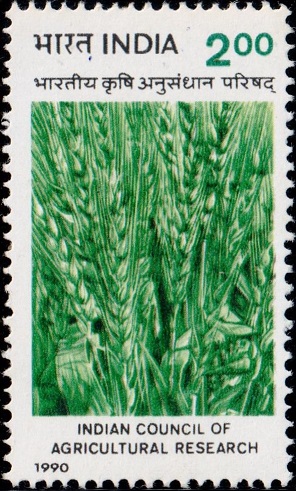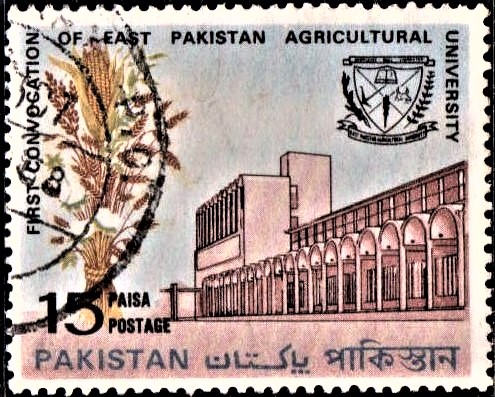
Indian Agricultural Research Institute
A commemorative postage stamp on the 100 years of the Indian Agricultural Research Institute (Pusa Institute), India‘s premier national Institute for agricultural research, education and extension :
 Issued by India
Issued by India
Issued on Mar 30, 2006
Issued for : The Department of Posts is proud to commemorate one hundred years of the Indian Agricultural Research Institute with the issue of a postage stamp.
Credits :
Stamp & FDC : Kamleshwar Singh
Cancellation : Alka Sharma
Type : Stamp, Mint Condition
Colour : Multi Colour
Denomination : 500 Paise
Stamps Printed : 0.8 Million
Printing Process : Photogravure
Printer : India Security Press, Nashik
About :
- The Indian Agricultural Research Institute (IARI), popularly known as the ‘Pusa Institute’, was originally established in 1905 at Pusa (Bihar) aided by a donation of £ 30,000 from an American philanthropist, Mr. Henry Phipps. Following a devastating earthquake in 1934, the Institute was shifted to its present location in Delhi. Ever since its establishment, the Institute has provided an inspiring leadership in the development of agricultural research infrastructure and technologies that led to India’s emergence as a food-sufficient country.
- The Institute has been playing a key role in agricultural research, education and extension in the country. The emphasis of the Institute on training researchers led to its acquiring the status of a ‘Deemed-to-be University’ in 1958. Besides basic research, applied and commodity research gained great importance resulting in the development of several popular high yielding varieties of almost all major crops and their associated management technologies, which brought about an unprecedented increase in the national food and agriculture production.
- The Institute has expanded from its original infrastructure of five Divisions to its current network of twenty Divisions, eleven dedicated Units, six National Coordinating Centres, five multidisciplinary Research Centres, nine Regional Research Stations and two off-season nurseries. The Institute’s library holds the largest collection on agro-biological literature in South Asia. The National Phytotron Facility is the only controlled environment and containment research facility in South Asia.
- The Institute is moving upstream with an increased thrust on strategic and basic researches which will not only keep enriching the stream of scientific knowledge, technology generation and product development, but would also enhance the nation’s competitiveness in this age of scientific revolution. The Institute has strengthened its existing key areas of research and education such as Molecular Biology and Biotechnology, Microbiology, Virology, Physiology, Biochemistry and Agrochemicals, Precision and Organic farming and bio-fuel research. Apart from crop improvement and breeding, the thrust has been shifted to new strategic areas such as exploitation of heterosis and development of hybrids, including apomixes, new plant types combining high biomass production with high harvest index, Market associated selection, identification of genes for resistance/tolerance to biotic and abiotic stresses, and creation of pre-breeding stocks combining multiple resistances and other desirable attributes.
- The Indian Agricultural Research Institute has significantly contributed to the growth of Indian seeds industry, by making available quality seed of nearly 175 varieties of field and vegetable corps.
- The Institute has spearheaded the development of new concepts, themes and methodologies in research initiatives, network project at National level extension and technology assessment and transfer.
- The Institute has been the harbinger of the Green Revolution and the flagship of Indian agriculture. The increased food production through the application of the Green Revolution technologies has been the corner stone of India’s food security and overall agricultural success.
- Text : Based on material given by the proponent.








[…] in Plant Genetics and Agriculture from the University of Cambridge, UK in 1933. He joined the Indian Agricultural Research Institute (then known as the Imperial Agricultural Research Institute), located at Pusa in Bihar in October […]
[…] of Deogarh. Scientific rose breeding on modern lines started during the nineteen sixties at the Indian Agricultural Research Institute (IARI) New […]
[…] On release, he continued his post-graduation and doctoral studies at Benaras Hindu University and Indian Agriculture Research Institute in Agricultural […]
[…] Indian Agricultural Research Institute has for some years now been breeding roses especially for Indian conditions, and the gardens of the […]
[…] order to overcome the barriers to high yields, the Indian Agricultural Research Institute, New Delhi, introduced from Mexico in 1963 a wide range of wheat material possessing the genetic […]